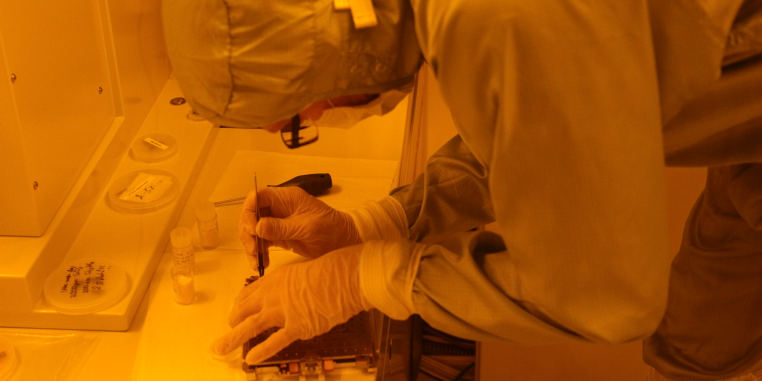

















The MNF is a state-of-the-art, 300 m² nanofabrication and nanoanalytics machine park classified from ISO 5 to 7. Located at the University of Münster, we provide nanostructuring and nanofabrication technologies for an interdisciplinary research community of scientists and engineers in physics, chemistry, earth sciences and biology, both within and outside the university.
If you are interested in exploring advanced nanofabrication and nanoanalytics techniques, the MNF is here for you.























Thank you for joining us on MNF Day 2024! We hope we inspired new ideas for your research.
This year's event had a great turn-out again and lots of positive feedback. Visit our MNF Day page for a review of the day.
A big thank-you to this year's sponsors: Nanoscribe, KLA (Filmetrics), IONTOF and Pixel Photonics!
MNF Day 2025 is tentatively scheduled for September 25th. Make sure to mark your calendar!

Ein Team um den Physiker Prof. Dr. Carsten Schuck und den Studenten Lukas Schulte sowie die Doktoranden Tim Buskasper und David Lemli hat den weltweit kleinsten QR-Code hergestellt. Mit einer Größe von 5,38 Quadratmikrometern ist er rund 20 Mal kleiner als der bisherige Weltrekord einer Forschungsgruppe aus Singapur und etwa siebenmal kleiner als eine menschliche rote Blutzelle. Die Arbeitsgruppe produzierte das Fabrikat mithilfe eines Elektronenstrahllithographie-Gerätes in den Reinräumen der „Münster Nanofabrication Facility“ (MNF). Hier arbeiten Forscherinnen und Forscher verschiedener Fachrichtungen sowie Masterstudierende im Praktikum „Grundlagen der Nanofabrikation“. „Die technische Ausstattung in der MNF ist hochmodern und kommt neben unseren Forschungsaktivitäten in der Quantentechnologie unseren Studierenden in innovativen Lehrformaten zugute, die in Praktika nanoskalige QR-Codes herstellen – wenn auch etwas größer als bei unserem Rekordversuch“, unterstreicht Carsten Schuck.
University News
AG Schuck / Department for Quantum Technology

In den Reinräumen der Münster Nanofabrication Facility haben Studierende und Forschende die Möglichkeit, mikroskopisch kleine Strukturen herzustellen, die mit bloßem Auge kaum zu erkennen sind. Sauberkeit ist das höchste Gebot: Ein Haar oder Staubpartikel könnte das Experiment zerstören. Die Teilnehmerinnen und Teilnehmer des Praktikums „Grundlagen der Nanofabrikation“ müssen sich daher an genaue Vorschriften halten.

Carsten Schuck’s research group is designing, building and testing a receiver unit for a quantum key generation process and the operation of secure communication in a gas pipeline system produced by PSI Software SE. “Any attempt at eavesdropping would be noticed immediately, rendering the key generation system independent of the measuring devices,” explains Carsten Schuck. His team is building this system at the Münster Nanofabrication Facility (MNF) using a special technology designed in-house. It uses superconducting single-photon detectors which are embedded in advanced photonic integrated circuits. The circuits are embedded in chips that are cooled to around two Kelvin in order to make the best possible use of their superconducting properties.
University News
AG Schuck / Department for Quantum Technology


The first cleanroom at the University of Münster was established in the Center for NanoTechnology (CeNTech) in 2003. Following the University's expanding presence in nanoscience, this original facility required significant upgrades to meet the needs of researchers and remain competitive with peer institutions.
Through the approval of the Center for Soft Nanoscience (SoN) research program, the WWU received a multi-million euro investment, including a capital equipment upgrade and several large instrument grants. In 2017 the MNF expanded into brand new cleanroom facilities in the SoN building.
Supporting its full transformation into the Münster Nanofabrication Facility (MNF), the Deutsche Forschungsgemeinschaft (DFG) provided funding in 2020 to establish the MNF as a core university facility providing services for university members and external users.